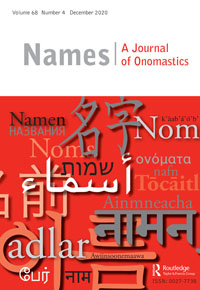“Harry, You Must Stop Living in the Past:” Names as Acts of Recall in John Updike’s Rabbit Angstrom
Published 2020-07-30
Keywords
- United States,
- college athletics,
- athletic conference names
Copyright (c) 2020 American Name Society

This work is licensed under a Creative Commons Attribution 4.0 International License.
Abstract
This paper studies the function of names as a stylistic device in literary fiction. The data are taken from John Updike’s Rabbit series, which depicts the life of US American Everyman Harry “Rabbit” Angstrom from the late 1950s to the 1980s. Special focus is on Harry’s peculiar habit of calling people and places by names that are no longer up to date: former nicknames, maiden names, names of shops that have gone out of business. It is argued that, in so doing, Harry is recurrently invoking memories of his own past. Updike’s use of names here reinforces, on an onomastic level, one of the major motifs of the novel: the protagonist’s infatuation with a former version of himself.
References
- Androne, Richard G. 2008. “Never the Right Food: Eating and Alienation in John Updike’s Rabbit Angstrom Saga.” In You Are What You Eat: Literary Probes into the Palate, edited by Annette M. Magid, 330–344. Newcastle: Cambridge Scholars Publishing.
- Backhaus, Peter. 2020. “You Don’t Mind my Calling You Harry? Terms of Address in John Updike’s Rabbit Tetralogy.” International Journal of Literary Linguistics 9, no. 4: 1–28 (in press).
- Baker, Emmalee D., Julia M. Chavez, and Robert C. Hauhart. 2015. “Religious Naming in John Updike’s Rabbit, Run.” The Explicator 73, no. 4: 275–278.
- Berryman, Charles. 1998. “Updike Redux: A Series Retrospective.” In Rabbit Tales: Poetry and Politics in John Updike’s Rabbit Novels, edited by Lawrence R. Broer, 17–33. Tuscaloosa: University of Alabama Press.
- Bramwell, Ellen S. 2016. “Personal Names and Anthropology.” In The Oxford Handbook of Names and Naming, edited by Carole Hough, 263–278. Oxford: Oxford University Press.
- Brown, Roger and Marguerite Ford. 1961. “Address in American English.” Journal of Abnormal and Social Psychology 62, no. 2: 375–385.
- Buck, Paula R. 1998. “The Mother Load: A Look at Rabbit’s Oedipus Complex.” In Rabbit Tales: Poetry and Politics in John Updike’s Rabbit Novels, edited by Lawrence R. Broer, 150–169. Tuscaloosa: University of Alabama Press.
- Coates, Richard. 2018. “Linguistic Aspects of Literary Name Origination.” Onoma 53: 11–31.
- Culleton, Claire A. 1994. Names and Naming in Joyce. Madison: University of Wisconsin Press.
- De Bellis, Jack. 1988. “The ‘Extra Dimension’: Character Names in Updike’s ‘Rabbit’ Trilogy.” Names 36, no. 1–2: 29–42.
- De Bellis, Jack. 2000. The John Updike Encyclopedia. Westport: Greenwood Press.
- Heritage, John. 1984. “A Change-of-State Token and Aspects of Its Sequential Placement.” In Structures of Social Action: Studies in Conversation Analysis, edited by John M. Atkinson and John Heritage, 299–345. Cambridge: Cambridge University Press.
- Hopper, Paul J. 1991. “On Some Principles of Grammaticization.” In Approaches to Grammaticalization, Vol. I: Focus on Theoretical and Methodological Issues, edited by Elisabeth C. Traugott and Bernd Heine, 17–35. Amsterdam: John Benjamins.
- Keener, Brian. 2005. John Updike’s Human Comedy: Comic Morality in the Centaur and the Rabbit Novels. New York: Peter Lang.
- Miller, D. Quentin. 2001. John Updike and the Cold War: Drawing the Iron Curtain. Columbia & London: University of Missouri Press.
- Moore, Jack B. 1998. “Sports, Basketball, and Fortunate Failure in the Rabbit Tetralogy.” In Rabbit Tales: Poetry and Politics in John Updike’s Rabbit Novels, edited by Lawrence R. Broer, 170–188. Tuscaloosa: University of Alabama Press.
- Newman, Judie. 1988. John Updike. New York: St. Martin’s.
- Pinsker, Sanford. 1993. “Restlessness in the 1950s: What Made Rabbit Run?” In New Essays on Rabbit, Run, edited by Stanley Trachtenberg, 53–76. New York: Cambridge University Press.
- Updike, John. 1960. Rabbit, Run. New York: Knopf.
- Updike, John. 1971. Rabbit Redux. New York: Knopf.
- Updike, John. 1981. Rabbit is Rich. New York: Knopf.
- Updike, John. 1990a. Rabbit at Rest. New York: Knopf.
- Updike, John. 1990b. “Why Rabbit Had to Go.” New York Times Book Review, 5 August, 24–25.
- Updike, John. 1994. Conversations with John Updike. Edited by James Plath. Jackson: University Press of Mississippi.
- Updike, John. 1995. Rabbit Angstrom: A Tetralogy. New York: Everyman’s Library.
- Updike, John. 2000. Licks of Love: Short Stories and a Sequel, Rabbit Remembered. New York: Knopf.
- Updike, John. 2016. John Updike’s Pennsylvania Interviews. Edited by James Plath. Bethlehem: Lehigh University Press.
- Waldron, Randall H. 1984. “Rabbit Revised.” American Literature 56, no. 1: 51–67.
- Wood, Ralph C. 1998. “Rabbit Angstrom: John Updike’s Ambiguous Pilgrim.” In Rabbit Tales: Poetry and Politics in John Updike’s Rabbit Novels, edited by Lawrence R. Broer, 129–149. Tuscaloosa: University of Alabama Press.

